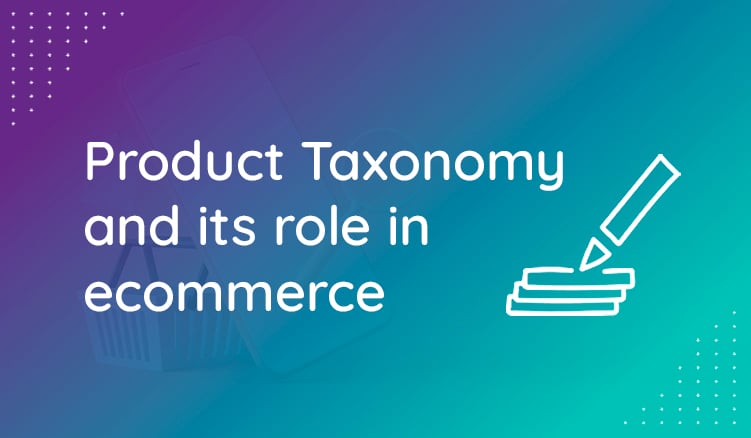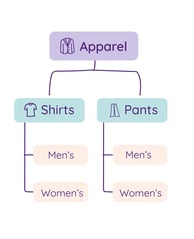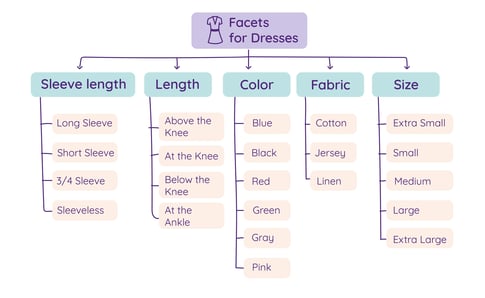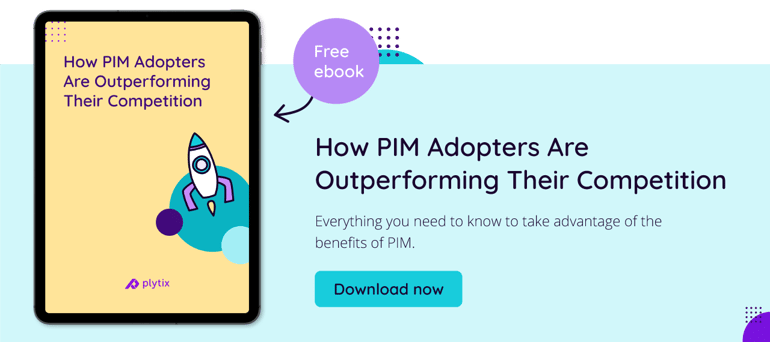Product Taxonomy and its Role in Ecommerce

Keep the good stuff coming
Subscribe to our blog newsletter and get monthly content that helps you manage product data smarter.
No spam. Just real value.
There’s just no excuse for poorly categorized content anymore.
Without product taxonomy, you’re willingly jeopardizing your rankings and sales potential. In fact, you might as well proceed to the second page of Google and bury that dead body you’ve been hiding.
What is taxonomy?
Taxonomy is part of the site's information architecture (IA). It is a system that focuses on organizing and labeling structured and unstructured content in an easy to understand manner.
Why do you need taxonomy?
To help customers find what they’re looking for through categories, attributes, and values. Statistics show that 75% of users leave a site if they do not find what they are looking for in 15 seconds. It’s no wonder poorly architected retailing sites sell 50% less than better-organized sites.
Only 10% of ecommerce websites actively address taxonomy, and only 16% of ecommerce giants provide a good filtering experience (Nordstrom, Macy’s, Dell, and Apple). Based on these stats, it is clear that a rising exit rate and a drop in sales is not (only) due to a glitch in marketing activities.
Precise, user-friendly taxonomies do more than look pretty; they impact your bottom line.

What are the most common types of taxonomies?
Hierarchical and faceted taxonomies. They have a lot in common; however, your choice will simply be determined by your product needs and the size of your ecommerce website. Facets give you more room for growth without affecting the main hierarchy of your taxonomy structure. It is common that businesses use a combination of both for the best results.
1. Hierarchical. Many people are familiar with the hierarchical taxonomy. It is a traditional, controlled approach that appears in a tree-like format. How it works is that you have one parent category that is subdivided from general to specific child subtopics. This data is predominantly text-based and suited for small websites.

2. Facets. This structure is used for rapid filtering on big websites with large volumes of product information. Customers are not required to know the specific search term, meaning searchers and browsers can combine multiple attributes to find what they’re looking for. These attributes can be text, numeric, or date-based.

Facet Source
Taxonomies are a work in progress
They are forever evolving. It is not a once-off structure; it requires changes as your business grows. To make things even more complex, this product information might need to be transformed when you expand and distribute your content to certain marketplaces.
The process for each channel should always be consistent, especially when adding new products to an existing structure. This can be quite daunting when you are dealing with large volumes of data, which is why it is best maintained in a Product Information Management system. In a PIM tool, you can tweak your data through computed attributes to ensure your taxonomies are correctly formatted.
How do you create a taxonomy?
1. Research. Sit down with your marketing team, and analyze your customers’ behavior and shopping patterns. Look at how people engage with your site. For example, what search terms they use and how they browse. These insights, paired with a deep understanding of your product, will help you make logical decisions. Only once you have made a concrete decision can you proceed to the design stage of your taxonomy.
Good to know: lead with the most concise, relevant information for your industry. Successful retailers actually look at the competition on each taxonomy of their competitors’ and categorize products where the competition is the lowest. This gives them the green-light to capitalize on opportunities not being touched on in the industry yet.
2. Testing. In the planning phase, review your taxonomies regularly and test content. Walk through a search offline, and document your experience as you navigate through it. Put yourself in your customers’ shoes and test your taxonomies from a facet and a general hierarchical point of view. Does the journey make sense? Because at the end of the day, your success is based on your customers’ engagement with your content. Document any issues to revisit or thoughts that need to be added to your data governance guidelines.
What makes a good taxonomy?
A taxonomy that drives positive results supports your content marketing strategy and your audiences’ needs. It’s not just a case of stringing content together for the sake of it; it needs to be functional and make sense to those who are engaging with it. Your approach needs to be uniform for multiple taxonomies and across different channels. While this will always be a work in progress, you want your content to be easy to manage so that it allows for regular tweaks.
How to optimize for taxonomy?
Within your taxonomy content, you need to incorporate SEO.
This will ensure your content is easy to reach for your customers and easy to understand for Google’s search crawlers. Do your keyword research, and seamlessly integrate keywords that are highly relevant to your product offerings and your taxonomy structure and URLs. Now, it can get confusing (and even messy) when you have an extensive taxonomy. So, we suggest incorporating breadcrumbs that link back to the main category. This detail will help Google understand the structure of your site, allowing you to build authority on the category topic.
On each product detail page (PDP), create a short introduction about the product with suitable keywords. Take this opportunity to link back to existing blog articles, or even other product pages, to create link juice and a well-rounded internal linking approach. Don’t forget about your metadata. This, along with the actual taxonomy design, takes time to perfect. Keep all of your SEO-friendly content centralized in the PIM, so that you can easily optimize and format content as and when needed.


Managing taxonomy with PIM
Managing taxonomy manually is a burden. It is time-consuming, mundane, and can lead to errors. This content should be managed in a PIM, much the same as any product content. By using this intelligent software, you can automate your taxonomies. Simply auto-categorize your content and enable metadata or tagging suggestions. Incorporate these process changes into your governance policies so that everyone is aware of how to approach your taxonomies. This way, whoever accesses this content has a trustworthy document to revert back to, to maintain consistency throughout the company.
Ready to get started?
See how many PIM adopters have already achieved incredible results just by categorizing their content. You can too! Book a free meeting to have one of our dedicated account managers help you build a sustainable taxonomy that’ll make your path to purchase as seamless as possible.
Learn everything you need to know about a PIM tool or book a consultation for more!

What if your product data actually worked for you?
We’ll show you how Plytix helps you stop fixing data—and start using it.
Related posts
Keep the good stuff coming
Subscribe to our blog newsletter and get monthly content that helps you manage product data smarter.
No spam. Just real value.






Think others should see this?
Go ahead and share it.